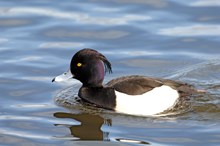21 December, 2020
More people flock to Loch Leven reserve in 2020

NatureScot’s Loch Leven National Nature Reserves (NNR) saw an upsurge in visitors in 2020, as part of over a million estimated visitors to NNRs across Scotland. The figure is an increase from an estimated 650,000 in recent years.
The increase, initially due to lockdown, was followed by continued interest and enthusiasm across the nation for spending time in nature in this difficult year.
Winter is a wonderful time to continue that habit. There’s plenty to see at Loch Leven, from whooper swans to pink-footed geese to squirrels and deer, and they’re often easier to spot at this time of year because of the bare trees.
NatureScot Chief Executive Francesca Osowska said: “People throughout Scotland have been enjoying spending time outdoors more than ever in 2020. Nature is helping us all cope with anxiety throughout this difficult time and strengthening our resilience. I’d encourage people to get out and enjoy their local national nature reserves over the holiday season, following the latest government guidelines. Our nature reserve staff have highlighted some spectacular sights to see on our reserves this winter.”
First off, there’s a special treat at Burleigh Sands with a unique take on the 12 days of Christmas. Follow the signs to find the 12 Birds of Christmas, which ends at a bird hide where visitors can hopefully then spot all the birds from the trail and be able to identify them. Many families, dog walkers and visitors have already enjoyed the trail.
The loch is known for pink-footed geese, with the mass migration of these pinkish-grey geese from Iceland bringing a large winter population to the loch. Around 85% of the world population of pink-footed geese winter in the UK every year. The goose counts at Loch Leven have been good this year, with 11,407 pink-footed geese in October and 9,301 in November. The geese have been very active and can be seen leaving the loch at dawn to feed in the fields, giving everyone a morning wakeup call. The geese are known for their loud honking calls, which can often be heard when they fly in their typical v-formation in large flocks or skeins.
There have also been sightings of six little egrets, with other notable sightings including eight Slavonian grebes, 1500 coots, 580 goldeneye, 500 mute swans, 2000 tufted ducks and 200 whooper swans.
Finally, a new viewing screen opened at Loch Leven in September, providing a lovely view of the northern area of the loch. Visitors have enjoyed a long-staying long-tailed duck this year – a rare sight at the loch – which favoured the spot in front of the new screen.
Francesca has some final words of advice for those visiting nature reserves: “It’s been amazing to see so many people enjoying our reserves this year, but we’d also like to remind people to protect our reserves for future generations. For example please don’t litter or light campfires, as these can damage plants, trees and wildlife.”
ENDS
Contact information
- Name
- NatureScot Media
- Telephone
- 0131 316 2655
- media@nature.scot
Notes to editors
NOTES TO EDITORS
There are 43 National Nature Reserves in Scotland. These are special places that look after some of the best of Scotland’s nature on behalf of everyone who lives or visits Scotland, and they provide unique opportunities to visit, enjoy and learn more about Scotland’s nature. For more information, see see https://www.nature.scot/enjoying-outdoors/scotlands-national-nature-reserves
NatureScot is Scotland's nature agency. We work to enhance our natural environment in Scotland and inspire everyone to care more about it. Our priority is a nature-rich future for Scotland and an effective response to the climate emergency. For more information, visit our website at www.nature.scot or follow us on X at https://x.com/NatureScot
’S e NatureScot buidheann nàdair na h-Alba. Bidh sinn a’ neartachadh àrainneachd na h-Alba agus a’ brosnachadh dhaoine gu barrachd suim a chur ann an nàdar. Tha e mar phrìomhachas againn gum bi nàdar na h-Alba beairteach agus gun dèilig sinn gu h-èifeachdach le èiginn na gnàth-shìde. Tha an tuilleadh fiosrachaidh aig www.nature.scot no air X aig https://x.com/NatureScot




